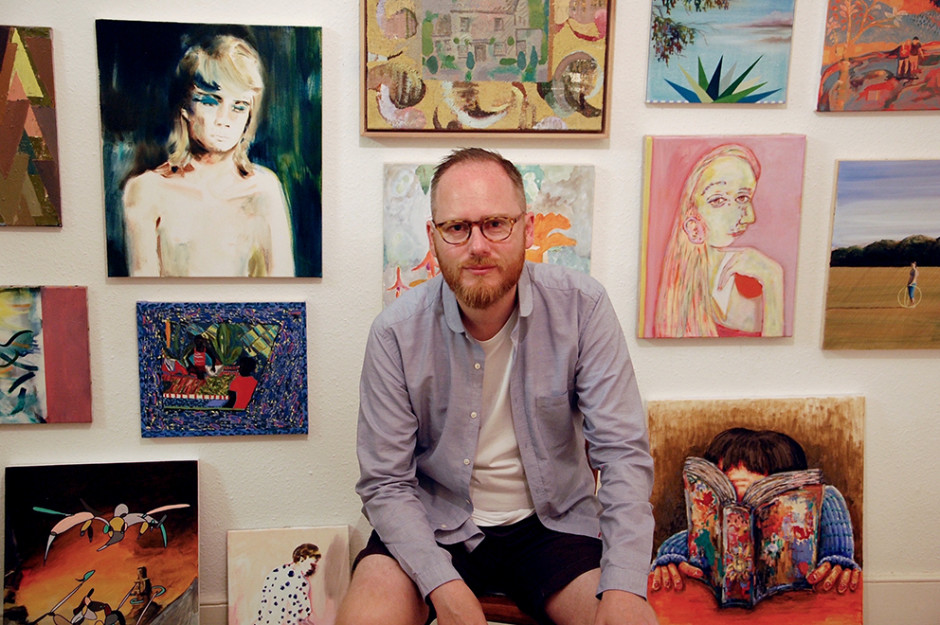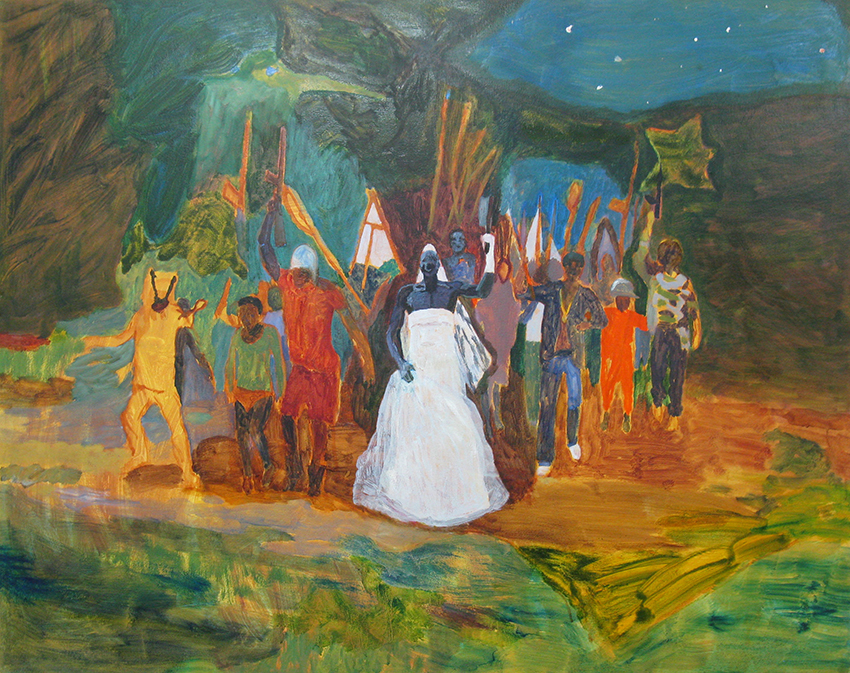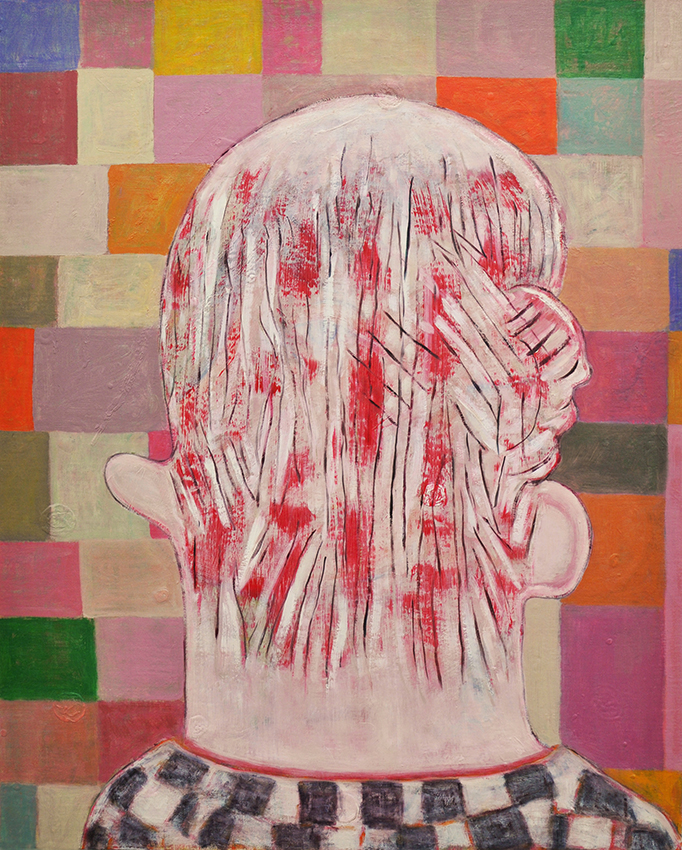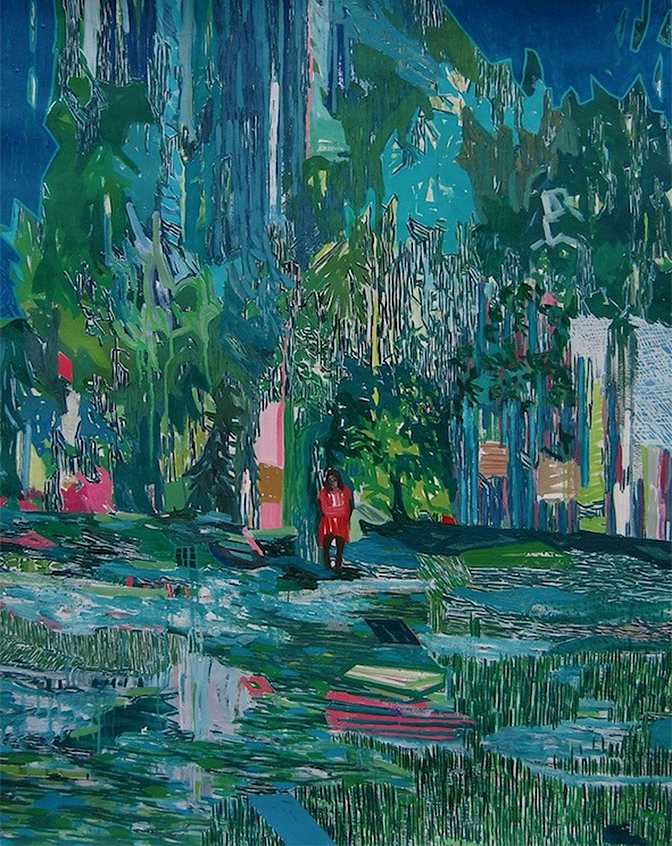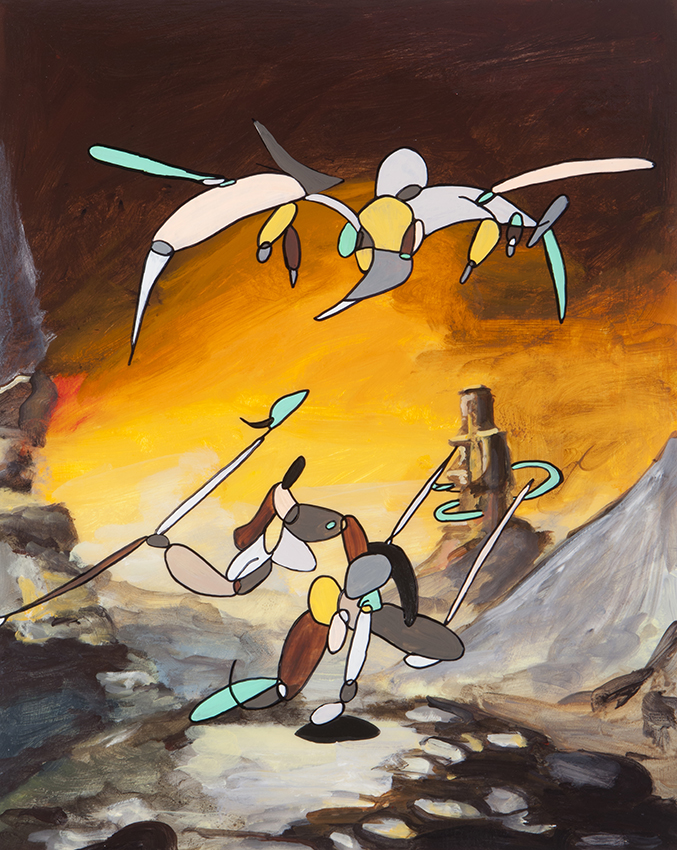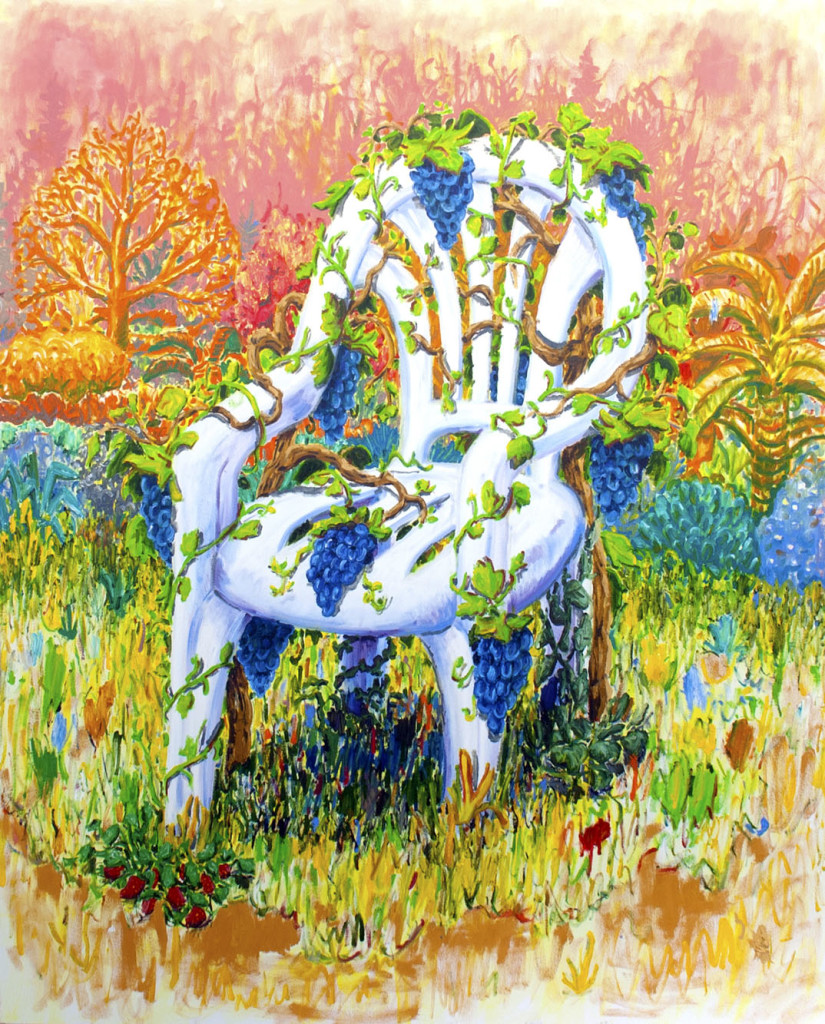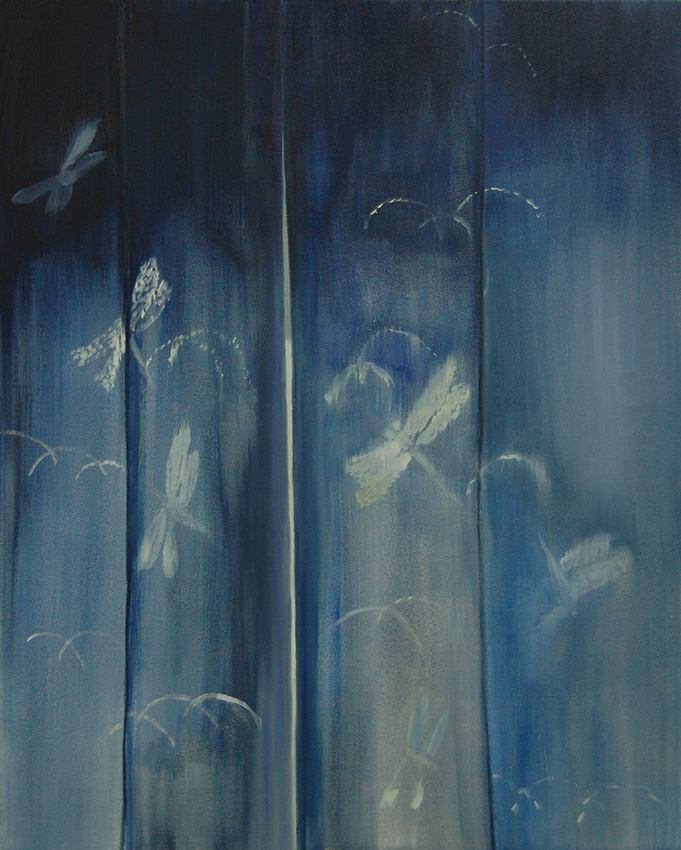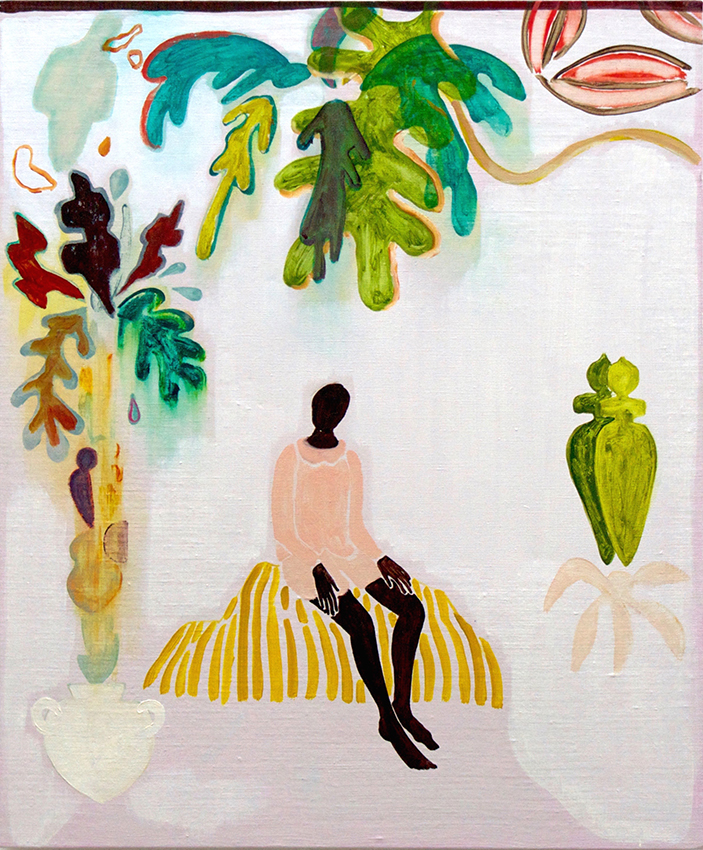Kristian Day has been selling art for most of his professional life, but only recently has he set up in business himself, inspired by the current generation of British painters – a generation that has been becoming more visible and increasingly connected through social media, painting initiatives around Britain, and London’s vibrant gallery circuit. As Day opens his ‘Sampler’ exhibition, giving a taste of some of the artists he is working with, Fused thought it would be a good moment to meet him and sample some of the paintings for itself…
Since the turn of the millennium you have spent most of your time in Mayfair selling modern and contemporary painting – what are the things you most enjoyed about doing that?
Kristian Day: Well, Mayfair is a different world isn’t it? Working for a gallery in that part of London is very much like being the top and bottom half of a swan and these days – with rents being what they are, you have to paddle a hell of a lot faster just to keep afloat. There’s a constant pressure to make sales so when a show goes well it gives you more a feeling of momentary relief than enjoyment. But in the midst of all the stress it does have its moments. There’s a myth that the people collecting from Mayfair galleries are all city boys or oligarchs looking for an investment, but in my fifteen years working there I can count the people who fit that description on one hand. The enthusiasm of collectors is always a joy. I had a number of ‘regulars’ who were just as likely to come in for a chat and a cup of tea as they were looking to buy something and I loved building those relationships. The thing is to understand that you are working for the artists as well as the gallery – the two things go hand in hand. The realization that your work is actually making a difference to an artist’s life is something that inspires me in my work.
For much of this time you were working for well-established galleries – what was it that inspired you to go it alone and set up your own business?
Many reasons, though in particular I’d started to notice great artists around, like Caroline Walker, Benjamin Senior or Paul Housley, and I became increasingly aware that there was a lot happening beyond the gallery I was working with, and I wanted to get involved. I should say that ‘going it alone’ is perhaps misleading as I’ve had a great deal of support, not least from my wife Lizzy. I’ve said from the start to all the artists I’m working with that I see the business as a partnership between us all – one in which everyone can contribute ideas and collaborate on projects together.
Eleanor Moreton, Ni Wendo Munene, 2016. Oil on canvas, 97 x 122 cm.
You’re now a dealer pretty much exclusively in contemporary British painting – is this an exciting time for painting in Britain?
It’s always an exciting time for painting isn’t it? Great painting and painters have always been around, though I guess maybe the press are taking it seriously again and some galleries seem more open to presenting it now, especially alongside other mediums. I try not to think too hard about it, though, as I don’t want to get bogged down with trends or markets. I recently saw Jeffery Camp’s show at Artspace Gallery in Islington – he’s in his 90s and producing great work; Rose Wylie is amazing and in her 80s. So yes, it is an exciting time for painting but I think it always will be.
Is it rare for a dealer to specialise like this in one medium today?
Do you know, I suppose it is! Although I have to admit that I didn’t go into this with any grand game plan to just deal in painting, I just naturally gravitate to painters. I found it funny when people started calling me ‘the painting guy’ – in fact, I’m quite chuffed with that, and there are worse things to be called, I suppose! For the record I do love other mediums but there is something about paint that just resonates with me as a form of expression.
Aly Helyer, Pin Striped Head, 2015. Oil on linen on board, 77 x 62 cm.
You’re currently working with around thirty artists, which is a lot. Is it difficult to maintain good relationships with them all at once, as well as with your clients?
Ha! You’d have to ask them! I do try my best to stay in touch and on top of what everyone is doing – in fact it’s probably the most enjoyable part of my job. As you know, I’m constantly in and out of studios but even if I’m not I’m usually on the phone or emailing / facebooking / instagramming / whatsapping with them. The ‘Sampler’ show that I’m about to launch is a bit like spinning plates though – there are twenty-seven artists involved so even collecting the work is a logistical challenge. Poor Simon Burton had to tell me he was on holiday three times before it sank in. I’ve had to put together a very detailed spreadsheet to keep up with it all. I worry that someone might feel they’re not getting enough attention at times but it’s probably more likely they wish I’d leave them alone!
How would you characterise the kinds of painting you are particularly drawn to?
That’s a pretty impossible question to answer! I suppose it’s the immediacy of paint that attracts me. You can get the ideas out almost as soon as they enter your head. You don’t have to book a foundry or an editing suite, it’s just… there. I think I’m personally attracted to paintings that have a painterly quality to them, a textural surface, strong colour, pattern and imagery, a critical edge, and I confess I enjoy a nice bit of mess. I like the human touch so I’m not naturally drawn to anything too hard edged or photographic, but I reserve the right to change my mind at any given moment!
Some of the artists you’re working with are emerging names and recent graduates, but others are more established, mid-career and with international exhibition histories. Could you tell us a little about the range of artists you have on your books?
I don’t really think about age or career status when I approach artists. I make a point of seeing the work in real life before introducing myself in the hope that I am responding to the work itself. But yes, I do think I have a good range of artists working with me. I have three recent graduates whose work I saw at degree shows; others I came across as they were nominated for awards recently; some I’ve been secretly following for years but until I decided to set up in business I didn’t have a good enough reason to turn up on their doorstep! If, as a collector, you’re looking at their pedigree then I don’t think you’d be at all disappointed with the gang but, as I said, it’s the work that comes first for me.
Kathryn Maple, Backwaters 4, 2015. Oil on paper, 150 x 120 cm.
Do you think there’s an interesting relationship between twentieth-century painting in Britain and what is going on at the moment?
Yeah, definitely, you hear names dropped and quite often see the same books and catalogues lying around in everyone’s studios, but if you’re a painter, you’re bound to look at twentieth-century work. What’s interesting is how they are using these influences to respond to life today. There are aesthetics that come with living in the twenty-first century that are inescapable. Even painters who seemingly try to reject this are responding in some way. You were probably hoping I’d list some twentieth-century artists who have particularly influenced these painters, but I’ve learnt the hard way that it’s probably best not to bring that up, well, not in their presence anyway!
It seems there’s hardly a private view of a painting show you’re not at, whether degree shows, at museums and public galleries, or commercial galleries – presumably this is essential for how you work?
As Matthew David Smith would put it, I get FOMO (or ‘Fear Of Missing Out’ for those of us on the wrong side of forty). I just genuinely want to see the work that’s out there. Also, when you work on Cork Street for so long it’s very easy to get isolated within that particular world, so when I left, I made a point of trying to catch up with everything else. It is getting a bit obsessive though – at the last count I’d been to over 300 shows in just the last three months, literally wearing through two pairs of shoes in the process. And no, it’s not just for the free beer if that’s what you’re thinking. There is a serious side to it though. I’d noticed a couple of dealers who look for artists online and then invite them in. I wouldn’t buy a painting like that and I certainly wouldn’t take on an artist in that way. Also, I want my projects to be collaborations so I make a real effort to get to know the artists first. It is important to me that I know I can work with them and, hopefully, they can at least tolerate me. Adam Hedley recently said to me that it’s nice to find a dealer ‘on the same level’ as the artists, which I took as a real compliment.
Henny Acloque, Fentanyl, 2015. Acrylic on board, 50 x 40 cm.
From seeing some of the recent degree shows, it seems there’s what one might describe as a ‘renaissance of painterly painting’ going on in art schools at the moment. Firstly, do you agree, and if so, why do you think that is?
Oh I could go on all day about some of the artists I’ve seen at degree shows this year: Faye Wei Wei feels like a star already; Dickon Drury’s work felt like it had started a scene; likewise with Harry Bland, Yuchu Gao, Antonia Showering, and Margaux Valengin; Alex Gibbs’s final show was phenomenal and Anthony Banks is something else, a ‘real’ painter if such a thing exists. The list is endless; I know because I actually made a list. So yes, I agree that there is something exciting happening with painterly painting at the moment, which is wonderful for someone like me. As to why it’s happening you might be better off talking to their tutors but I doubt it’s one thing alone. There seems to have been a shift recently towards an appreciation of more painterly painters.
On social media you’re known for being the man that’s got his finger on the pulse of contemporary painting in London – how important is social media to your work these days?
I don’t know how ‘on the pulse’ I am – I just follow my gut instinct. I promise you that if painting ever becomes deeply unfashionable then I’ll continue doing what I do. It’s funny that the social media side has taken off in some way for me. I originally used Instagram as a way of documenting where I’d been and who I’d seen without filling up the memory on my phone, but a lot of people seem to enjoy following my adventures around town so that’s great. I follow a lot of artists on social media too as I really want to keep up to date with their work and how it’s developing, not just artists in London but around Britain and internationally. As for how it affects my work, it’s nice when an artist that I like or a new collector recognises me from social media; it’s often a good ice-breaker as you already have a specific exhibition, artist and so on in common to talk about, but I still prefer a face-to-face meeting than an email or message, and from my experience most collectors and artists feel the same way.
Willem Weismann, Dionysus, 2015. Oil on canvas, 160 x 130 cm.
There’s a sense that social media is connecting painters in Britain to a much greater degree than they have ever been before – would you say that’s true, and how are the benefits manifesting?
When I first started working for galleries I was surprised to discover that some artists were terrified of going to their own private view – it hadn’t occurred to me that they’d pretty much been working in isolation in the months or years building up to that moment. It’s still the standard set-up as an artist that you go into your studio and work alone every day, but now at least you can interact with your peers, your fans and people you admire, as and when you feel the need to reach out. Once you’re out of the student life then feedback becomes a rare thing, even the most headstrong of artists must have doubts about their work and that’s only going to be amplified if you’re cut off from your contemporaries. So yes, social media is connecting painters and, even if it’s something as unimportant as getting a few ‘likes’ on a picture you’ve posted, it’s at least a bit of positive feedback. Again, this isn’t just from the guy working in the next studio, it’s a platform that enables like-minded artists to share work and ideas globally. Knowing you’re not alone and having that kind of support network around the world must be having positive effects on painting.
Aglaé Bassens, The Night Between You and I, 2016. Oil paint on canvas, 76 x 61 cm.
Smaller and independent initiatives such as the Marmite Prize, Turps Banana, Beep Wales, the W. Gordon Smith Award and Contemporary British Painting are playing an increasingly important role alongside larger organisations such as Jerwood and John Moores. Is there a sense that the dots are beginning to be joined up in contemporary painting in Britain in ways that they have perhaps not been in the past? Is there a tangible community emerging?
All these initiatives are just fantastic, particularly the Marmite Prize and the Turps Banana school. There is a do-it-yourself ethic underneath it all somewhere that I truly admire and I do like to think that they’ve added to the connectivity of all that’s going on in painting at the moment. I’m wary of saying that the dots are being joined up though – I like to think of them more as examples of artists supporting each other, and perhaps without needing the blessing of established institutions. Having said that there have always been independent societies and groups that have attempted similar things and they often evolve into the establishment – so it might be better to answer that at some point in the distant future!
Anyone who follows your Instagram feed will know that you like to visit a lot of artist studios – how important are studio visits to you and your work? Is it an aspect you particularly enjoy?
I’ve learnt to be a bit sensitive during studio visits – you are, after all, walking into someone’s private space. There may be works there never intended for public viewing, or works in progress at a delicate stage of development. I would be mortified if I said the wrong thing and threw an artist off track. Internally though, I’m like a kid in a candy shop. When working in Mayfair visiting studios was an all-too-rare treat for me, so being invited to studios these days is a real pleasure. Getting a feel of the process behind the works, rather than just being presented with the finished article, is great for me and fascinating for the collectors I know too, so I like to be able to drag some of them along with me sometimes.
Do you have plans to open a gallery at some point in the future? Will you take on representation of some of the artists with whom you work?
Yes, and yes, hopefully!
You’re currently curating a number of exhibitions – could you tell us a little about them?
The first show is called ‘Sampler’, and features one piece by each of the artists I’m working with, so far. It opens on 25 August (2016) at Arcade Fine Arts near Old Street. Next up is ‘Landing’ which features the work of Anna Freeman Bentley, Hannah Brown and Freya Douglas-Morris, and opens on 30 September at The Contemporary London near Ladbroke Grove. After that I have plans for some solo exhibitions with Andrew Seto and Anthony Banks and I’m starting to put together a new mixed exhibition called ‘Dumb’, and I’ll be announcing more details about that shortly.
So the ‘Sampler’ exhibition is literally like a taster show for some of the artists you’re working with?
Yes, it’s a taste of things to come really. I’m also using it as an official launch for everything I’m doing, so I hope it will be a fun night. I have a lot of paintings to fit in so expect a salon hang! It will also be an opportunity for all the artists to get together and meet for the first time – it’s a small world but not that small.
Are there a lot of collectors supporting contemporary British painting at the moment, or is it a small group of hardcore supporters? Would you say that there is a new generation of collectors emerging for their work?
I’d say all of the above! We all know that times are hard and that a lot of galleries are struggling but I do see, as you say, a new generation of collectors appearing. What is just as encouraging is that an older generation of established collectors of modern art are starting to look at contemporary art, particularly painting, and they are buying because they recognise the quality of the work out there at the moment.
Where does your passion for painting come from?
It depends how far you want to go back. I had a great art teacher at school who would basically look after me – she let me see that art could be a way into a different kind of life to what I’d been exposed to previously. She let me borrow her art books and we’d drink coffee and listen to the Velvet Underground, it was bliss. I don’t think I’ve changed that much since then to be honest.
All images courtesy of the artists and Kristian Day.
‘Kristian Day / Sampler’ is on show at Arcade Fine Arts, 87 Lever Street, EC1V 3RA over the August bank holiday weekend 2016.
‘Landing’ opens at The Contemporary London on 30 September. For further details visit www.kristianday.co.uk
Matt Price

